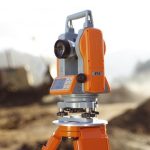Shows a sectional view of a typical Vernier theodolite and plate 16.1 shows photograph of such theodolite. Main parts of such a theodolite are:
1. Telescope: A telescope is mounted on a horizontal axis (trunnion axis) hence it can rotate in vertical plane. Its length varies from 100 mm 175 mm and its diameter is 38 mm at objective end. Its functions is to provide a line of sight.
2. Vertical Circle: A vertical circle graduated up to an accuracy of 20′ is rigidly connected to the telescope and hence moves with it when the telescope is rotated in vertical plane. The graduations are in quadrantile system, 0-0 line being horizontal
3. Vernier Frame: It is a T-shaped frame consisting of a vertical arm and a horizontal
Arm. With the help of the clamping screws the vertical frame and hence the telescope can be clamped at desired angle. Vertical frame is also known as T-frame or index frame. The Vernier arm is known as index arm. At the ends it carries Vernier’s C and D so as to read graduations on vertical circle. They are provided with glass magnifiers. Altitude bubble tube is fitted over the horizontal arm.
4. Standards or A-Frame: The frames supporting telescope are in the form of English letter ‘A’. This frame allows telescope to rotate on its trunnion axis in vertical frame. The T-frame and the clamps are also fixed to this frame.
5. Upper Plate: Upper plate supports standards on its top surface. On lower side it
is attached to a inner spindle which rotates in the outer spindle of lower plate. Using upper clamp, upper plate can be clamped to lower plate. Using tangent screws, it is possible to give slight relative motion between the two plates, even after clamping. Two diametrically opposite Vernier’s A and B fixed to upper plate help in reading horizontal circle graduations. They are provided with magnifying glasses.
6. Lower Plate: The lower plate, attached to the outer spindle carries a graduated circle at its bevelled edge. Graduations are up to an accuracy of 20′. It can be clamped at any desired position using lower clamps. If upper clamp is locked and the lower one is loosened the two plates rotate together. If the upper clamp is loosened and lower clamp locked, upper plate alone rotates. This mechanism is utilised in measuring horizontal angle.
7. Plate Level: One or two plate level tubes are mounted on the upper plate. If the two level tubes are provided they will be at right angles to each other one of them being parallel to trunnion axis. These levels help in making the vertical axis of the instrument truely vertical.
8. Levelling Head: It consists of two parallel triangular plates known as tribrach plates. The upper tribrach plate is provided with three levelling screws—each one carried by an arm of tribrach plate. By operating screws the levelling of upper plate and hence telescope can be ensured. The lower tribrach can be fitted into a tripod head.
9. Tripod: Theodolite is always used by mounting it on a tripod. The legs of tripod may be solid or framed. At the lower end the legs are provided with steel shoes to get good grip with the ground. The top of tripod is provided with external screw to which the lower tribrach plate can be screwed. When not in use tripod head may be protected with a steel cap, provided for this purpose.
10. Plumb Bob: A hook is provided at the middle of lower tribrach plate from which a plumb bob can be suspended. It facilitates exact centring of the theodolite on a station.
11. Shifting Head: It is provided below the lower plate. In this, one plate slides over another over a small area of about 10 mm radius. The two plates can be tightened in the desired position. It facilitates exact cantering of the instruments.
12. Magnetic Compass: In some theodolites a magnetic compass is fixed on one of the strands. It is useful if readings are to be recorded with magnetic north as meridian.


